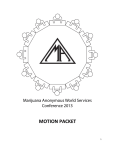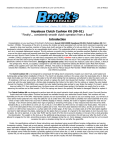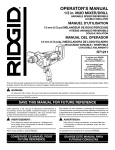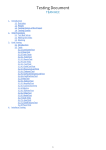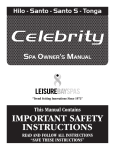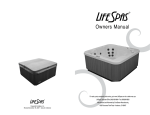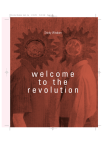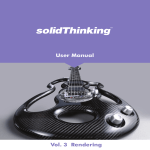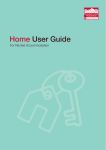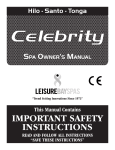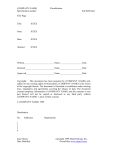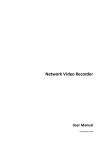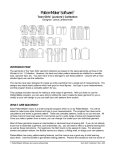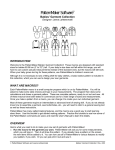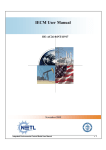Download Real Nappy Guide
Transcript
The Real Nappy Guide Helping you choose the right nappy for your child £2 where sold Your comprehensive guide to using real nappies What are Real Nappies? Cotton Nappies Real Nappies Washable Nappies Cloth Nappies Re-usable nappies Non-disposable nappies We’ve called them ‘real’ nappies because in the UK it is the term that organisations such as WRAP (Waste and Resource Action Programme), WEN (Women’s Environmental Network) and most councils use. Why ‘real’? Because they are not made from plastics and petro-chemicals. Real nappies are made from cotton and some may contain a small amount of polyester for strength and long life. They are designed to be washed in your washing machine after every use and can be used again and again, not just for one child, but for many. When they are not needed any more the fibres can also be recycled. This Real Nappy Guide will •e xplain the health, financial and environmental benefits of using real nappies •h elp you decide which nappy is best for your baby •e xplain how to store and wash your nappies •a nswer any questions you may have regarding real nappies Unfortunately real nappies are associated with negative images of old-fashioned terry towelling squares and the time and effort they used to involve. In fact, real nappy use is growing every year thanks to easy-to-use modern real nappies. This guide will show you how easy and costeffective real nappies really are! 2 the real nappy guide Contents Real nappies are a great all round choice for you and your baby. This guide will show you why and will make it easy for you to choose the right nappy. Pg 4 What do parents think? Pg 7 Will using real nappies make it easier to potty train? Pg 6 Health, costs and environment Pg 10 Choose the right nappy for your child 4 Why go back to cotton? Real nappies save you money, are easy to use and look great. 6 Health, costs and the environment Real nappies benefit everyone; your baby, your pocket and the community. 10 Which nappy? There are many styles to choose from, they are all easy to use and are a fashion statement. We aim to make your decision an easy one. 11 Nappies explained Some terms you may come across when using real nappies. 12 Getting started Choosing real nappies is easy once you know where to find them. 13 Nappy changing Useful tips to make nappy changing really easy when you’re at home and out and about. 14 Using & washing It’s easy – if you’ve got a washing machine you can use real nappies. 16 Nappy folding instructions Your step by step guide to using terries and flat nappies. the real nappy guide 3 Why go back to cotton? All over the country parents are realising the benefits of real nappies. They are not the chore they once used to be. It wasn’t very long ago that parents used real nappies for their babies and in most parts of the world real nappies or no nappies are still the norm. Disposable nappies have only been around for the past 20 years. So what did parents do before disposables and how do parents in other countries manage? What do parents think ” Sarah with callum, full time mother of 2 at present. by profession she is a registered nurse: The one thing that did take me by surprise with using cotton was the fact that the nappy really does get wet! I had been so accustomed to the dryness of disposables it was a bit of a shock at first, but I soon got used to the idea. Callum, however doesn't seem to notice any difference between the two types of nappy. Callum occasionally gets slightly damp skin from a very wet nappy but the one way liners keep him mainly dry. Cotton nappies are a lot softer and a much better fit. Even after a 60 degree wash and no fabric softener they remain soft to touch. As for nappy rash, Callum only gets it when he's teething, and that was the case when he wore disposables as well. ” Nappies around the world In Africa and India it is common for babies to 'potty train' between 6-15 months, in Western countries it can be any time between 18 months to 3 years. So how do they do it? Just like mothers who know instinctively when their babies need to be fed, it is possible to learn the cues that your baby gives when it is ready to empty its bladder or have a bowel movement. These sounds or movements are usually very subtle but can be picked up. What the mothers then do is anticipate when the baby needs to go, then hold the baby over a potty and make the noise 'ssssssss', (which resembles running water) the baby then associates this sound with doing a wee and will, once learnt, wee 'on demand'. Turning back to real nappies As well as health, cost and environmental issues, the most convincing argument is the fact that modern real nappies are far easier to use than most people imagine. Velcro fastenings, nappies shaped to fit and soft breathable waterproof wraps make using real nappies a pleasure. ■ nappies through time 4 VICTORIAN MOTHER MOTHER OF THE 1950’s Before running water and electricity using nappies required hard manual labour. Nappies might be made from ‘tailclouts’ the tails of the fathers old shirts. Plumbing and electricity makes washing nappies a little easier. Turkish terry towelling nappies were the norm. the real nappy guide What do parents think ” ” Rob first time dad and electrical engineer with baby Jessica We use cotton nappies because we don’t like using nappies with chemicals. With cotton there will never be a health scare because we’ve been using cotton nappies for centuries. Jessica has only had nappy rash once when she was teething and it quickly cleared up. What do parents think ” LUCY AND MEGAN At the post-natal group everyone was intrigued by what Megan was wearing on her bottom. No one noticed any difference outwardly as the nappies fit so snugly and her clothes fitted well over them, but when I changed her everyone was fascinated, including my health visitor who wanted more information on these modern washable nappies. In the summer, especially on holiday she looked gorgeous in her soft pretty nappy wraps and everyone said how sweet they looked and how soft and ‘teddy bear’ like she felt to hold ” Leaking I’ve heard real nappies leak? A real nappy and cover are no more likely to leak than a disposable nappy. Simply check the nappy is tucked inside the cover, any cotton that protrudes from the cover will wick moisture from the nappy and onto any clothing or bedding it may be in contact with. Use a booster pad(s) if you find you have to change a wet nappy more than every 3 hours. Some babies just wee more that others! When buying the next size of wrap look at the thigh openings as well as weight range of wrap to suit your baby’s shape. mother of 2005 mother of the 1970’s Terry squares, pins and PVC pants are the only choice. Carefully designed nappies and washing machines make using real nappies easier than ever. the real nappy guide 5 Health, costs and the environment Real nappies are made from cotton, a natural fibre, cost less and create far less waste. Chemicals or Cotton? With real nappies you know exactly what’s next to your baby’s skin. There are no plastics in a real nappy. For many years, organisations such as Friends of the Earth, Greenpeace and The Womens’ Environmental Network have voiced concerns over the safety of disposable nappies and have raised awareness of the waste issue. Causes of Nappy Rash The experiences of nappy rash below are taken from parents and not health professionals. Parents mostly agree that if a baby is susceptible to nappy rash then s/he will get it from time to time wearing disposables or washables Thrush may need to be treated by a doctor (nappies should be washed at 90 degrees until the thrush has gone) ● changing How often should a nappy be changed? Babies should be changed as soon as they have soiled their nappy or every 3-4 hours during the day if just wet to avoid nappy rash. At night time nappies can be left on longer. Is there an alternative to expensive throwaway wipes? Wipes are expensive, contain strong chemicals and create waste. If you want to save yourself money invest in some flannels or cut up an old sheet or towel. When changing a soiled nappy use toilet paper first (that can be flushed along with the soiled liner) then cotton wool or a cloth wipe. The wipes can be washed along with the nappies. 6 the real nappy guide Babies changing from disposables to washables can sometimes get a slightly red bottom as the skin’s normal moisture balance is resumed (disposables can sometimes dry the skin out) ● What do parents think ” Laura Jardine first time mum and gymnastics coach, with Kobi My mum is very ‘green’ so I have been brought up with an awareness that the environment needs to be looked after and that we should be doing our best to preserve it for the next generation. I am not a big user of chemicals whether they harm baby or not seems to be a big debate at the moment so why take the risk? There is a physical advantage to using real nappies that as a gymnastics coach I am attracted to. Real nappies hold a baby's legs wider apart than disposables which helps in the development of strong hips. ” the three r’s Most councils adopt the 3R’s (Reduce, Reuse & Recycle) policy as the only long term solution to reducing waste. What does this mean for nappies? Reduce The amount of nappy waste going to landfill by using real nappies Reuse Use real nappies that can be used again and again for more than one child. When you have no need for them, sell them or give them away for someone else to use. Recycle When your nappies eventually wear out, the fibres can be recycled into something more useful. Teething can cause the pH of the urine to change and the stools can become runny. ● Colds and other illness can cause a change to babies’ urine and stools. ● Eczema can appear worse in the nappy area; babies usually grow out of this but it can sometimes be caused by an allergic reaction to chemicals in wipes and/or disposables or washing detergents. If the latter is responsible then redness is usually where the nappy is at its closest contact with the skin eg: around the waist. Wash nappies with usual detergent then wash again with none and put on an extra rinse cycle too; this helps get rid of any build up of detergent, then only use a tablespoon of detergent over the next few washes to see if this makes a difference. ● Alternatively, change your detergent to a gentler brand with no perfumes etc. Ask your nappy stockist for advice. ● If the baby does not get cleansed thoroughly at each change then germs left on the skin can cause a rash. Equally if a baby is left in a soiled nappy for a long time then a rash will develop. ● A change of milk or new food in the diet can again cause changes in the stools. ● Be sure you can keep the temperature constant. In countries where parents do this, the occurrence of nappy rash is very low.) You could also try cleansing the skin with cooled chamomile tea. Chamomile is soothing and gentle on the skin. Some parents find that placing a booster pad soaked in chamomile tea and a few drops of tea tree oil in the nappy against the skin helps clear rashes. ● Treating nappy rash Whether you are using washables or disposables you can try the following if baby gets a rash. Seek medical advice if you are worried about a rash or it is particularly bad or persistent. Otherwise try some of the following: ● If a slight rash appears then stop using baby wipes as these can really sting! Use plain water to cleanse baby (if you can get a steady warm stream of water from a shower then run baby’s bottom under that. ● ● Leave the nappy off where possible and let baby kick on a changing mat letting air get to the bottom. Use a thin barrier such as olive oil or vitamin E oil gently massaged onto the skin to retain the skin’s moisture and act as a barrier to urine. ● If baby is not allergic to eggs, whisk up 2 egg ● Potty training Will using real nappies make it easier to potty train? Washable cotton training pants look just like ordinary underwear but come with an in-built waterproof layer. If children wear disposable pull-on training pants they are unable to feel wet and may be harder to potty train. If your child doesn’t make it to the potty on time cotton training pants will stop their clothes from getting too wet, but the child will feel wet and will be able to make the association. the real nappy guide 7 nappies at night time What about at night? Real nappies can be used at night. If your baby is a heavy wetter you can use extra booster pads. It is nicer for your baby to wear real nappies at night time, as they could be in a nappy for up to 12 hours. For some children the night nappy is often the last one to go, it’s not uncommon for children to still need a nappy at night at 7 years old. Financial costs Having your first child can be one of life’s great joys but can also be one of life’s big financial surprises. Most people are aware of the costs for the new baby such as clothing and equipment but most are surprised to learn that they will need to spend £5-10 per week on disposable nappies. That’s more than half their weekly child allowance and up to one fifth of their average weekly shopping bill, literally thrown in the bin! The cost may seem affordable, but real nappies will save you money in the long run. A birth to potty set of real nappies can start from as little as £70 and you are unlikely to ever spend more than £400 for your first child; this includes the initial purchase and the estimated costs for washing and depreciation of the washing machine. Once you have bought your real nappies all nappy changes are free and you can start saving money, especially with subsequent children. Savings to councils whites until stiff and apply thinly to the bottom. Let it dry and then put the nappy on! Lots of mums really find this works well believe it or not!! If baby gets really sore then try keeping baby as dry as possible using a stay-dry liner; polyester fleece liners work well. Still use your flushable liner on top of this. Some parents who use cotton nappies will use disposables to dry out the skin if a rash is bad. If this works for you then do it, but do return to your washables afterwards. ● ● Use a zinc and castor oil cream. Use a raw silk liner right against baby’s skin inside the nappy; silk has natural healing properties. A silk liner used overnight will often completely clear rash. (available from washable nappy stockists). ● Finally if you have any top tips you would like to share with others let us know and we’ll add them to our list!! 1 Women’s Environmental Network 8 the real nappy guide Every year councils spend at least £40 million disposing of disposables1 This money comes out of our council taxes. Wouldn’t you rather see that money being spent on something more useful to our communities? Environmental Costs Each baby using disposable nappies can produce up to half a tonne of nappy waste a year. For a family with one child in nappies, disposables can make up half the content of their rubbish each week. Most nappy waste ends up in a landfill site somewhere. Landfill space is rapidly running out and UK councils are being encouraged by the Government and Europe to make more use of the 3R’s – (see box on page 7). Disposable nappies are mostly made from non-renewable oil resources and wood pulp. Real nappies are made from renewable cotton. Why is nappy waste such an issue? Councils are keen to reduce waste going into landfill sites. For every tonne of waste councils have to pay a tax of £15 per tonne (from April 2004) plus the costs of collecting the rubbish from your home and movement Real nappies are bulkier than disposable nappies – will they restrict my baby’s movement? There is no evidence to suggest that using a cotton nappy restricts a baby’s movement or damages a child’s growth. Disposable nappies have only been on the market for the last 25 years or so. Most adults would have been in terry towelling. Has it affected how you walk? transporting it to the landfill site – this can be anything from £20-£40 per tonne. Disposable nappy waste can end up costing councils hundreds of thousands of pounds. Is your council doing its bit? Some councils have already implemented projects with the aim of encouraging parents to use real nappies. The Real Nappy project in the Bristol area has been operating for 5 years and has funding to undertake work in Bristol, Bath & North East Somerset and South Gloucestershire. Jane Stephenson, the Director of the Recycling Consortium which runs the project is enthusiastic about its success "The Recycling Consortium is committed to reducing the volume of waste going to landfill. We do this by supporting local people, groups and businesses to act in a sustainable way by helping them to incorporate the 3R's into their everyday thinking. The Real Nappy project is an ideal example of the 3R's in operation and it has provided jobs at a local level, so we see it as a far more sustainable option in many ways.” communities, bringing people together to tackle their own waste problems in a practical way to help create a cleaner world for future generations.” Rachel Turner – Chair Suffolk Real Nappy Network Why worry about waste? As parents we want to ensure that the world our children and grandchildren inherit is one that is sustainable. The landfill sites we have created are going to be around for many centuries to come. Even though recycling rates are increasing, the UK is still landfilling more waste than ever before. Every one of us can make a difference to reduce our own household rubbish, not just for our own good but for that of future generations. ■ “The Ipswich Real Nappy Network has been so successful at reducing nappy waste that we are now, with funding from the Big Lottery, local councils and WRAP, able to expand across Suffolk and give all parents the opportunity to find out more about cloth. In 2 years we have diverted over 1,500 tonnes of waste from landfill and provided over 2,000 people with information on real nappies. It’s all about involving local the real nappy guide 9 Which nappy? There is a huge choice of real nappies available; they can all be divided into 3 main categories all-in-one nappies A cotton inner permanently attached to a waterproof cover fastened with Velcro. The whole nappy can be machine-washed and tumble dried. Advantages • Easy to use – the most similar to disposable nappies in design and ease of use. • Convenient for quick changes when you’re out. • Quick to put on a wriggly toddler. Disadvantages • May take longer to dry than shaped or flat nappies as the outer is attached. • As the outer is washed each time, the nappy lasts only for one baby, maybe two. • On average they cost more than shaped or flat nappies. two-part shaped nappies A piece of cotton cut and sewn to fit the baby snugly, usually fastened with Velcro, a water-proof cover fits over this. The cover does not need to be washed every nappy change. Advantages • Shaped nappies will last at least two children, often as many as four • Cost less than all-in-one nappies. • Shaped to fit – no folding needed. Disadvantages • Not as easy to use as all-in-ones as you have to do two things - put on the cotton nappy, then the waterproof pants. • Usually take longer to dry than flat nappies. If you have a tumble drier this would not be a problem. • They cost more than flat nappies. two-part Flat nappies A square or piece of cotton is folded to fit inside a waterproof cover. The cover does not need to be washed every nappy change. Pre-folds, muslins, Terry squares and stuffable/pocket nappies fall into this category. Advantages • The cotton insert dries quickly as it is usually one sheet, which opens flat for quick drying. • Turns can be folded in may ways to suit your baby’s shape. • A set will last for many children. • This system is the cheapest of the three. • Stuffable nappies are as easy to use as all-in-ones. Disadvantages • Not as easy to use as all-in-ones or shaped nappies as each time . you have to fold the nappy to fit the baby and the waterproof pants. • Slim babies don’t always fit prefolds well, there can be a gap between baby and nappy. • Stuffable nappy covers need to be washed every time they are used so you need to have around 8-12 covers per size. They are also likely to deteriorate quicker due to frequent washing. 10 the real nappy guide Nappies explained Some terms you may come across when using real nappies Biodegradable liners Made from thin, strong paper, these allow wetness to pass through and are useful for catching solids. The whole liner and any solid waste can be flushed down the toilet avoiding the need to sluice. Some liners you can buy in the high street are usually made from thin plastic and should not be flushed. Gusseted legs An extra piece of fabric around the leg opening of Velcro fastening pants, which helps to prevent leaks. Raw silk nappy liners If your baby suffers from nappy rash, placing a raw silk liner next to its skin will help get rid of it. Raw silk has a natural therapeutic property that heals sore skin. Reusable nappy liners Once any soiling has been tipped down the toilet they can be washed along with the nappies. Sluicing Swim nappies and pants are useful for holidays and trips to the swimming pool, just in case baby soils itself! Training pants They look like ordinary underpants but have a waterproof layer that stops clothes from getting wet. Breathable pants Waterproof pants Keeps baby’s clothes dry and prevent leakages. Some can also be breathable. Cheaper pull-on ones are made from PVC and are not breathable. Used with a shaped nappy to prevent the baby’s clothes from getting wet. They cannot be used with a flat nappy unless it is fastened with a pin, Nappy Nippas or tied on first. If you use these covers with a shaped nappy the baby will not be able to undo the nappy itself, as it can with a Velcro fastened cover. A problem with cheeky toddlers! Terry Towelling Squares Waterproof Velcro fastening wraps Still popular nappies thanks to Nappi Nippas. Available from some nappy retailers, supermarkets and chemists and by mail order. Used with a shaped nappy or a pre-fold nappy to prevent the baby’s clothes from getting wet. They fasten with Velcro at the front. Swim pants Stuffable/pocket nappies newborn nappies What kind of nappy should my new-born baby wear? A new-born can go straight into real nappies. In fact it’s easier to tell if a new-born baby is wet if it’s wearing a real nappy. If in the first weeks of having a baby you don’t feel like doing it yourself why not try a laundry service? Some services offer the option of delivering a set of real nappies and wraps to your home before the birth of your baby. The laundry service will provide new-born sized nappies. It also allows you time to try out your trial packs to see which ones suit your baby. For the first few weeks, a baby won’t wet its nappy heavily. Muslin squares make ideal nappies, these can be tied Adjustable size shaped nappy Waterproof pull-on pants If you don’t use biodegradable liners and the nappy is soiled it may have to be sluiced. This means holding it in the toilet and flushing. The power of the flush should remove all the soiling. The modern alternative is to use a long handled washing brush when holding the soiled nappy under a running tap. Nappies are not suitable when swimming as they hold too much water, weighing the baby down. Terry Towelling with Nappi Nippa Keeps baby’s clothes dry and prevent leaks. If the nappy gets saturated, breathable pants may not work as well as waterproof pants at preventing leaks. Tights and close fitting clothes may draw moisture through some breathable pants. Thick throwaway nappy liners These are polyester wraps with an integral polyester fleece liner, sewn on three sides and open at the front or back. Into this you ‘stuff’ a folded flat nappy or booster pads. This works like an all-in-one but has the advantage of drying quickly when washed. Very easy to use nappy. Raw silk liner Woollen nappy covers Made from pure untreated wool. They allow the skin to breathe, are absorbent and temperatureregulating (keep baby warm in cold weather and cool when it’s hot). Natural untreated wool does not need washing after each use, as it renews itself when aired. Soiling can be removed with a spot rinse. If washing is necessary use a wool wash. After washing use lanolin to make the woollen cover waterproof, available in solid or liquid form. If your baby suffers from eczema or has allergies wool is less likely to cause irritation. ■ Popper fastening nappy cover Nappy creams the real nappy guide 11 Getting started You change the nappies, your washing machine does the hard work. DRYING NAPPIES How long do real nappies take to dry? The best way to dry nappies is outside in the sunshine. Muslin and terry towelling squares dry the quickest, whilst all-in-ones take the longest. If you have a tumble drier you won’t have a problem whichever nappy you use. If you do have a tumble drier, put a dry towel in with the nappies to reduce the drying time. BELOW: A real nappy demonstration shows the variety of nappies that are available on the market. One of the reasons people don’t try real nappies is the perceived image of piles of terry towelling squares, dangerous pins, smelly buckets and pots of boiling nappies on the stove! This is not the case, real nappies are shaped to fit your baby, close with velcro, poppers or ties and are covered with waterproof pants so they don’t leak. They can be used with biodegradable liners that flush down the toilet so sluicing is a thing of the past. All real nappies can be washed on a 60-degree cycle and can be tumble dried. How many nappies do I need to get started? If you are going to do it yourself, for full time use (including nights) we suggest an ideal of between 18 to 24 nappies and 4 to 6 covers (if you are using shaped or pre-fold nappies). It is possible to only need 12 nappies and fewer covers but you will be washing more often – so it helps if you have a tumble dryer. The nappies are likely to wear out quicker with spinning over 1200rpm and tumble drying. Babies that are breast-fed are likely to soil their nappies less frequently than bottle-fed babies as breast milk is designed to meet your babies needs exactly, therefore there is much less waste. If you choose a style of nappy that has more than one size you only have to pay for the size that your baby needs, then get the next size up when appropriate. Remember, when your baby is out of nappies you can save them for your next baby or sell them to another parent. How do I find the right nappy for my baby? The best way to decide which cotton nappy to use is to try it out. Try 3 or 4 different nappies and use them one after another. Using real nappies in between disposable nappies does not give you a good idea of what they are like. Have a go when you have the time and energy, use them at least 4 times before deciding which one you like. When you’re happy with your choice, order a full set. You can mix and match nappies and covers until you find a combination that suits your baby. It is also worth considering who will be looking after your baby and changing its nappy. The shaped Velcro fastening nappies are easier to explain to a childminder or nursery than terries that need to be folded. You can have different nappies for different situations. Some people use thicker towelling nappies for nights and neater shaped nappies for days. Your local Waste Management office should have details of suppliers and laundry services. You can find their number in the phone book ■ what you need What else do I need to do it myself? • A bucket to store used nappies: a lid is not essential, but is preferable. • A nappy net: useful for transferring nappies from the bucket to the washing machine • Liners: either biodegradable or reusable these are not essential, but make it easier to deal with soiled nappies. • A long-handled washing-up brush: if the liner did not contain the soiling you can use a long- handled washing-up brush to remove it under running water. • Non biological washing detergent. • A wet nappy bag: for when you are going out, to take home a used nappy. 12 the real nappy guide Nappy changing This quick reference guide provides useful tips for nappy changing at home and away. ● Home & Away Toilet paper – use this to clean away the poo (just as you would do on yourself!). Flush this with your flushable liner or on its own. ● Home & Away Flannels or cloth wipes – wet with warm water from the tap and use to clean baby between nappy changes instead of using disposable chemical or perfume impregnated wipes. They also save you money in the long run. ● Away you may have to use a commercial wipe if you can’t access water – alternatively carry a small spray filled with water and perhaps a couple of drops of lavender and/or tea tree oil. ● Home A bucket with a lid and a nappy net. Put wet nappy and wipe into the nappy net (this lines the inside of the bucket making transfer from bucket to washing machine very easy). ● Away A wet nappy bag – usually made from nylon to store your wet nappies. ● Home & Away A waterproof changing mat. It is possible to buy PVC free changing mats, usually through independent nappy sellers. ● Home & Away Liners, either paper biodegradable throwaway or flushable. These are not essential but make poos much easier to deal with. Fleece or polyester stay-dry liners keep baby’s skin dry and can be used underneath a paper liner or on their own. ● Home A long handled washing up brush. If the liner did not contain all the poo you can use a long handled washing up brush to remove it from the nappy under running water. ● Away A spare wrap if not using an all-in-one (just in case!) the real nappy guide 13 Using and washing Using and washing real nappies is not difficult – it’s the same as washing any other clothes. Pre wash Before you put a cotton nappy on your baby it should be pre-washed at least twice. Like a wellworn towel a nappy gets better with use. The more you wash the nappy the more absorbent it gets, so it may need to be washed six times before it’s at its best. Nappies that contain hemp take longer to wear in. Caring for nappy covers When you have a new baby, your washing machine use will go up anyway. Using real nappies will probably mean you use the washing machine only an extra 2 times a week. The cost per child on your washing machine is approx £150 (includes wear and tear, electricity and detergents). disinfecting nappies If you want to you can soak nappies to help prevent stains setting, although this is not essential. Change the solution every day. Add one of the following to a bucket of water: • 1 tbs bicarbonate of soda • 2-3 tbs white vinegar • 5 drops of tea tree oil • 1 tbs of Nappy Fresh • 2 tbs lemon juice Most commercial nappy sanitisers are not recommended as they are usually biological and can ruin the elastic found in modern nappies. They are also more expensive and make the water smell unpleasant. The only commercial nappy soaker we recommend is Nappy Fresh. 14 the real nappy guide Nappy covers need special care and attention to keep them waterproof. Make sure you do not exceed the maximum temperature stated and always use a nonbiological detergent. The covers will last longer if they are hand washed, towel dried to remove excess moisture then air dried. If machine washing, do up the Velcro and turn inside out for thorough washing. Only tumble dry if the label specifies. If using wool wraps ask the supplier for care instructions. What about the smell? A bin full of disposable nappies smells far worse than a bucket of used real nappies. If you are keeping nappies in a bucket for longer than 48 hours, soaking them in a solution will reduce any odours. How do I deal with used nappies? If you are using a biodegradable flushable liner this can be flushed if it is soiled. If just wet you can throw it away or compost it, however, I find they will go through the wash once or twice before deteriorating. They tend to get caught in the rubber seal so check there when unloading your washing machine. Any soiling on the nappy can be scrubbed off in the sink using a long handled washing up brush. Afterwards give the sink a quick wipe with a sink cleaner. As an alternative to paper liners you could just use fleece or polyester liners. Poo usually drops off these or you may have to sluice the liner. If your toilet is near enough to the shower you can shower off poo into the toilet. Storing nappies for the wash: Place the cotton part of the nappy into a nappy bucket. A laundry net in the nappy bucket ensures a quick transfer of nappies into the washing machine; leave the net undone so the nappies can come out of the net and circulate well in the wash. ● No soaking is necessary… A few drops of your favourite essential oil in the container will make the container smell nice (but because you have flushed any pooh and you are not soaking in chemicals then the container does not usually get smelly). ● If you choose to soak see the box ‘disinfecting nappies’ below. Pour off the water in the toilet before putting the nappies in the machine. Soaking nappies can mean you can wash at a lower temperature and prevent stains occurring. ● Hand rinse your waterproof covers and drip dry in an airing cupboard if you have one (wash covers in the machine with nappies every now and again) NEVER soak waterproof or stuffable covers. Try and wash them with other clothes that can be washed at 40 degrees. ● Rinse your container out ( you can use a disinfectant if you prefer or hot soapy water). ● Rinse your bucket out (you can use a disinfectant if you prefer or hot soapy water). ● How do I wash nappies? When you have a couple of days’ worth of dirty nappies tip them from the bucket into the washing machine and put them on a short rinse and spin cycle then add the rest of your whites and non bio detergent on a 60 degree cycle. You can also use a laundry ball/disk. Always check washing instructions first, as different nappies have different maximum washing temperatures. You can wash nappies separately if you prefer by using a prewash cycle in order to rinse them with fresh water first. A 60 degree wash is adequate, some can be washed at 95 degrees. Boil washing is not necessary. Do not use bleach or biological detergents as they can ruin the elastic, and don’t use fabric softeners as they coat the cotton in chemicals. To make your nappies soft, use a tablespoon of vinegar in the final rinse. ■ Top tips ✓ Soft nappies ✓ After time and no fabric softeners, nappies may need softening up a little especially if you live in a hard water area. Soften nappies by tumble drying them when still a little damp. If you do not have a tumble dryer then give nappies a flap or a shake before you hang them up to dry, or rub the nappy together in your hands when dry (as if scrubbing a stain out by hand) this breaks up lime scale build up in the nappies. A small cupful of clear vinegar in the fabric softener compartment can help soften nappies in the final rinse. Stained nappies ✓ Staining can sometimes occur and the best way of getting stains out is to hang nappies out on a sunny day and the stains literally disappear. Daylight on a cloudy day will work but takes longer. Stains which remain will usually wash out in time. You can try squirting a stained nappy with lemon juice before storing for the wash. This can stop stains from setting, as can soaking soiled nappies in a water and bicarbonate of soda solution (a small cup of bicarbonate of soda in a bucket full of water). You can order a large tub of bicarbonate of soda from your local chemist. ✓ Stay dry nappies, especially those with fleece liners, tend not to stain. Also using thicker paper liners when baby is milk fed can help prevent staining. Smelly Nappies?! Most parents won’t experience this BUT for those who do this is caused by a build up of ammonia from urine Nappies need to be dried and aired for longer or soaked in a bucket full of water with 2-3 table spoonfuls of clear (or white) vinegar or a few drops of tea tree oil. Alternatively the vinegar or tea tree can be added to the final rinse (put in the fabric softener compartment of machine). ● ✓ OR nappies can be washed on a cold cycle first to get rid of urine thoroughly before the usual hot wash which can set the smell. (Hint the pre-wash cycle is not always a cold cycle so don’t use this instead) ✓ Add half a lemon to the wash! Or put a few drops of lavender and or tea tree oil on a hanky and pop in the tumble dryer. Alternatively half a sheet of “bounce” can be used in the dryer. Out and About, Nurseries and Childminders: ✓ Of course you can use disposables for the above times if you wish. But you can take your washables out with a reusable wet nappy bag or a carrier to pop used nappies in. Stuffables or all-in-one nappies are often the preferred option for these situations. Dry babies and protecting skin: ✓ While the paper, flushable liner keeps baby reasonably dry in cotton nappies, for really dry babies, staydry liners and nappies are available. These work by letting wetness through to the nappy but not back on to the babies skin. ✓ Barrier creams can be used but are not always necessary. Olive oil or Vitamin E oil massaged into the bottom make good natural moisture barriers. the real nappy guide 15 Nappy folding instructions Your step by step guide to using terries and prefolds putting on a wrap Fold for a new born 3 Take left hand corner of top layer across to form a triangle. 2 Fold in half again, with all corners at top left. 1 Fold Terry in half, upwards. 4 Turn whole nappy over. 1 Place wrap under baby wearing cotton nappy. 5 Fold in a third, then a third again, into the middle. (Fold into quarters for a tiny baby, so the resulting pad is narrower.) pleat fold 1 Spread nappy out into a diamond shape. 2 Pull each side of the wrap over the nappy and secure the Velcro. Make sure that no fabric is protruding from the legs or top of the nappy or else wicking will occur. 16 the real nappy guide 4 Take bottom corner up again, folding from a/b to make a pleat. 2 Fold down top corner, stopping a few centimetres short of the bottom corner. 5 Fold nappy in half vertically. 3 Turn the whole nappy over. 6 Place baby on nappy. Bring middle part up between legs. Fold sides one over the other and secure. kite fold 1 Spread nappy out into a diamond shape. Imagine a line running down the middle of the nappy, top to bottom. Fold left and right corners in to meet at that line. 2 Fold top corner down, like an envelope. 3 Bring bottom corner up. Adjust to suit baby’s size. neat fold 3 Fold down the top corner so that it just overlaps the bottom one. 4 Bring left and right corners to the middle of the top edge. 1 Spread nappy out into a diamond shape. 2 Fold bottom corner up into the centre, level with the other two corners of the diamond. Envelope fold 3 If using a booster add it now. 1 Lay nappy out in a diamond. 2 Fold each corner into the middle to form a square. 4 Fold into thirds to make a pad. 5 Holding the nappy at the bottom edges, open out at the top to make a nappy shape. Place liner on top if using one. If using a Terry put on baby using a Nappi Nippa, or place in velcro fastening wrap and put on baby. 6 For smaller babies reduce the length at stage 2 by overlapping top and bottom corners. the real nappy guide 17 folding a prefolD HOW TO USE A nappi nippa 1 padding in the middle 1 Place baby on the folded nappy; you may want to use a liner. Bring up nappy between the baby’s legs. 1 Lay out the prefold with seams running horizontally (across) 2 Fold 1/3 over from the right… 3 Then left 2 Pull the nappy over one hip and then the other. 5 Turn over and place in wrap before putting on baby. 4 Fan out back 2 extra front and back padding 3 Hold with one hand while you get hold of your nappi nippa 3 Fold left side over middle seam 1 Layout out prefold with seam running vertically (top to bottom) 4 Fold right side over, tucking under left side 18 the real nappy guide 2 Fold 1/3 up 5 Fan out back then turn over 6 Place in wrap before putting on baby 3 Place nappi nippa on nappy, hold down at the centre with thumb. Pull ring on one claw then dig into fabric until the claw stays in place. Repeat with other 2 claws ensuring you pull the Comfy cuddly cotton Written and produced: Eva Fernandes 0117 955 8881 • Photography: Martin Cheyney, Amanda Thomas www.amango.co.uk • Illustrations and cartoons: Julie Beer and Jim Bradley • Additional photography: Paul Jarrold, Eva Fernandes, Recycling Consortium • Design: Real 0117 3148 341 www.therealdesigncompany.co.uk No part of this publication may be reproduced by any means (including photocopying, or electronically by fax, email or Internet) without the written permission of the author. The Real Nappy Guide is sponsored by www.borndirect.com visit BORN and discover a different approach to parenting Printed on recycled paper.





















